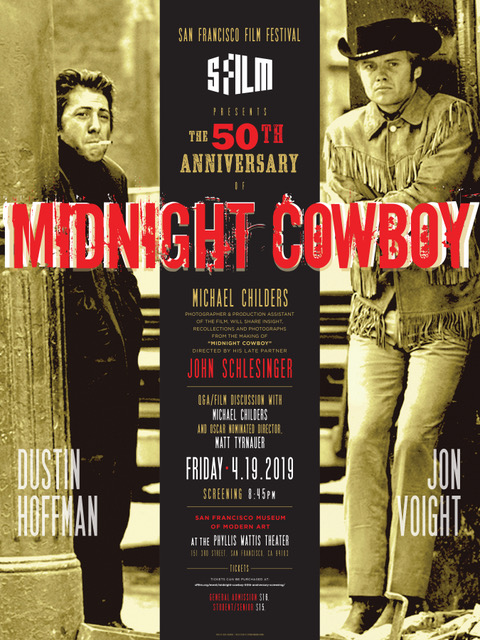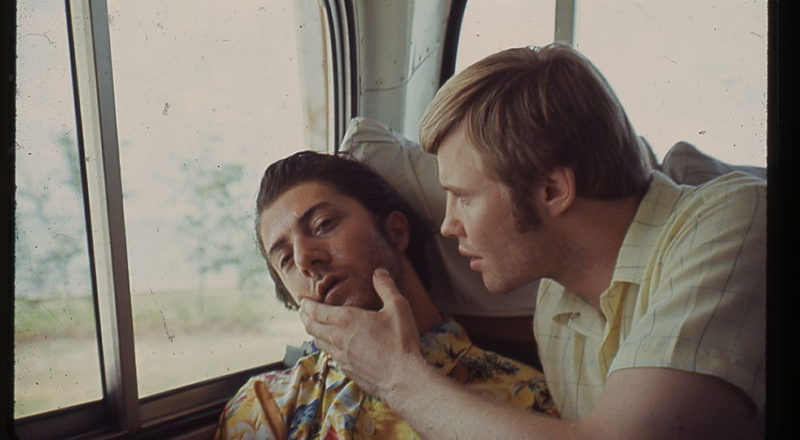INTERVIEW: Michael Childers to introduce ‘Midnight Cowboy’ on 50th anniversary

Photo: Midnight Cowboy, an Academy Award winner from 1969, stars, from left, Dustin Hoffman and Jon Voight. Photo courtesy of SFFILM Festival press site / Used with permission.
When John Schlesinger’s Midnight Cowboy was first released 50 years ago, the drama caused quite the stir. The flick infamously earned an X rating, but audiences and critics still responded with enthusiasm. And the movie went on to win Best Picture, Best Director (Schlesinger) and Best Adapted Screenplay (Waldo Salt) at the Academy Awards.
Today, audiences can still appreciate the gritty reality of the on-screen relationship between Jon Voight’s naïve Texan and Dustin Hoffman’s unreliable conman.
A central figure during the film’s production was Michael Childers, an assistant on Midnight Cowboy and Schlesinger’s life partner. He will be in attendance at a special screening of the drama Friday, April 19 at 8:45 p.m. at SFMOMA, as part of the SFFILM Festival this month.
“I was at UCLA Film School at 23 when I met John, and he asked me to work on the film,” Childers said in a recent phone interview. “I knew it was strange, X-rated, exciting, wonderful material, but we didn’t know — none of us knew — that it would turn out to be this little masterpiece that it turned out to be and a worldwide success. It was so exciting to work on this film and then see how the audiences reacted. Yes, it was the only Oscar-winning film to ever get an X rating, and, of course, now we look back at it and nowadays it’d probably be PG-13. It was groundbreaking and exciting, and it was also a very humanistic film. There’s a love story in there. It’s not a homoerotic love story, which some people think there is, but I think it’s about these two characters, outcasts, caring for each other, desperate to survive. And it’s a beautiful story.”
Childers has presented the film at festivals twice before, and he always finds it amazing that 60-70 percent of the audience has never seen the classic on a big screen.
“It’s like a first-time experience for many of these people, and that’s exciting to see their reactions, how the humor works, how the pathos [works],” Childers said. “Some people are in tears at the end. The power of the film still holds up. A lot of 50-year-old films, which are wonderful in your memory, [you] go back and look at them and say, ‘Well, that’s not as great as I thought.’ This still holds up very well, and it works. That’s the wonderful thing to expose it to a whole new generation of filmgoers.”
It was the beginning of Childers’ successful photography career when he joined the Midnight Cowboy team. Since those early days, he has led an impressive career. In addition to working with Schlesinger for many years, Childers became one of the most famous photographic documenters of artists and movement. His portraits and stunning photographs have captured men, women and their collective energy, passion and drive.
His many years in the business include such highlights as being a founding photographer of Andy Warhol’s Interview magazine and shooting images for covers of Dance Magazine, Esquire, Elle and GQ, among many others.
His biography for a recent photo exhibition — Michael Childers: Distortions at University of Southern California — lists the many institutions where his work is collected. The list is extensive: Academy of Motion Picture Arts & Sciences in Beverly Hills, California; Pittsburgh’s Andy Warhol Museum; Lincoln Center Library of Performing Arts in New York City; and London’s National Portrait Gallery.
“[At the time of Midnight Cowboy], I was working doing headshots,” he said. “I was doing book jackets. I was photographing personalities, and it was all just starting then. This was an amazing experience to move from L.A. to go to New York for my first time in New York to work on this, and meet Paul Morrissey and Andy Warhol. … In fact, Andy was going to be in the film, but a week before we started shooting, Andy was shot. That was horrible.”
Childers has fond memories of his times with Warhol.
“Warhol even then in the ’60s was so famous and was a magnet for all the great artists and talent in the world,” the photographer said. “John and I would go down to Max’s Kansas City and join Andy and Paul Morrissey at the table, and then the whole world was there. Besides the superstars, there would be Salvador Dali and Robert Rauschenberg and some of these great artists — Paloma Picasso, Yves Saint Laurent. It was a circus of fame, and Andy loved the rich and the famous.”
He added: “In fact, that’s how I got my job on Interview magazine. I was a contributing editor for a few years on Interview because I was working for a magazine called After Dark magazine.
“[Warhol said]: ‘I like your pictures of After Dark. They’re so beautiful and sexy. I’m starting a new magazine. Would you come and work for me?’
“I said, ‘What’s it going to be called? What is it? What do you want?’
“‘It’s going to be called Interview, and I want pictures of beautiful people and famous people. And if they’re rich, that’s even better, so beautiful and rich.’
“I said to Andy, ‘Well, are you going to pay?’ Long pause. He was notoriously cheap.
“So he said, ‘Well, I’ll make your pictures big and beautiful. I’ll print them really big.” That was an entree to a whole different world through Andy Warhol, working for Andy Warhol’s Interview. It certainly helped my photography career.”
On Midnight Cowboy and 100 other films, Childers would photograph actors and cinematographers. He was often hired by studios and magazines to showcase the behind-the-scenes look of Hollywood.
“Each new film was a great experience and a challenge,” he said. “It was great when I knew some of the stars in the film. Many of them would request me on their films, and that certainly helped a lot. It was amazing to see certain directors and how they worked. Cameramen — I was always interested in camerawork and cinematography to see how some of the great cinematographers would light sequences. It was a learning experience. It was a life adventure. I was in Morocco. I was in Egypt. I was in Prague. I was in Berlin. I was in Munich. I was in Manila, Philippines working on The Year of Living Dangerously with Linda Hunt, Sigourney Weaver, Mel [Gibson]. They were great, great experiences. The studios don’t hire photographers to do that anymore, which is sad.”
To learn the necessary photographic skills, Childers experimented and learned from the masters. That learning continues to this day.
“I love photography,” he said. “I love the great master photographers. I had a huge collection of photography books. I think it’s good to have a reference, to know what happened last century or in this century. Some of the greatest photographers, like Herb Ritts and Greg Gorman, they have huge libraries, and they do their research. You have to know what came before you in order to go forward and create something yourself. I think that’s important.”
He added: “I’m learning. The world of digital is very exciting. I’m learning constant things about it. I miss film so much. I have a show opening tonight in Palm Desert. It’s a show called Distortions in My Mind, and it’s male and female nudes that I did. It took about five years to do this, that I shot in funhouse mirrors on large-scale film. It’s beautiful. The quality is so beautiful and the reproduction of the prints. I miss film. I might still go back and work on it. I’m going to try some portraits on 8-by-12 film. It’s good to go back and challenge yourself and do new things.”
His fans can probably guess that Childers is not thinking about retirement — now or ever. The photographer said he did not know the meaning of that dreaded word.
“It sounds like the most terrible word,” he said. “At age 75, I’ve never been busier. I have six-seven exhibitions this year, including two at Yale University this year, and that’s really exciting.”
He also plans more festival appearances in the future. He will never tire of telling stories about Midnight Cowboy.
“My title [for the film] was a strange thing called production assistant,” Childers said. “Well, production assistant means getting coffee to the star’s door or picking up their dry-cleaning or getting their scripts to their hotel at night, but it could also be a great learning thing to do work with casting and extras and going out with your camera and doing locations. I was so lucky. I drove around Texas with Jon Voight once he was cast as the Midnight Cowboy for 10 days. I was photographing for locations and people’s faces, trying to find extras, and Jon Voight had his recorder and was learning how to speak Texan because he’s from New York. … The opening sequence was my idea of the drive-in movie theater, abandoned drive-in theater out in the middle of the Texas prairie. That was something I found out on the highway when Jon Voight and I were driving around. Also the party sequence — in the book, it says, ‘A party in Greenwich Village ensues.’ That’s all it said. It didn’t say a loft party or a Warhol party, so that was my idea. We just met Andy Warhol. Let’s turn into a Warhol-type loft party and use some of the Warhol stars and the underground people who were in New York at that time.”
There are many stories like this. For example, at the SFFILM Festival, Childers plans to play Voight’s screen test, a seven-minute video that secured the actor his job.
“Jon Voight was not cast as the Midnight Cowboy,” he revealed. “I’m showing the screen test, which is about seven minutes long, of Jon Voight because he was considered the second contender. … We all had to go back to the drawing room and look at the screen tests, and we said, ‘Oh my God, Jon Voight is so much better for that character because he has this pent-up anger and aggressiveness as well as a gentle quality as well.’ So it made Jon Voight a huge international star.”
Childers will bring this wealth of experience and his fond memories of working on Midnight Cowboy to the SFFILM Festival Friday night. Some of the stories he relayed to Hollywood Soapbox will no doubt be part of the Q&A session: how the casting of the film came to be, what production was like with Schlesinger, the controversy surrounding the X rating and his long partnership with the director.
By John Soltes / Publisher / John@HollywoodSoapbox.com
SFFILM Festival presents a 50th anniversary screening of Midnight Cowboy, with Michael Childers in attendance, Friday, April 19 at SFMOMA in San Francisco. Click here for more information and tickets.


John,
Great interview . 👍👍👍❤️❤️